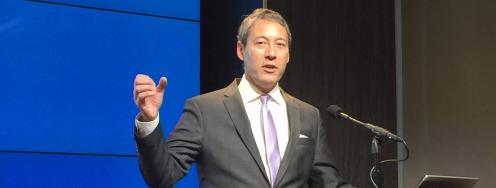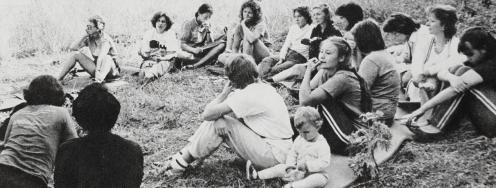Will Obama End the Nuclear Era?
There are times when you can feel the hinge of history moving. This is one of them.
This week, heads of state fly from Beijing, Moscow, London, Brasilia, Islamabad, Ankara, Kuala Lumpur, Tokyo, and dozens of other capitals for the largest summit of world leaders called for by a president since the founding of the United Nations. Why?
The short answer is to stop nuclear terrorism. The goal is to forge a new global plan to stop al Qaeda or any other terror group from getting the one part of a nuclear weapon they cannot make themselves: the uranium and plutonium cores.
Do that and you prevent a nuclear 9/11. Fail, and most experts think it is just a matter of time before one of these capitals disappears in a mushroom cloud.
On day one of the nuclear summit, Ukraine committed to getting rid of its weapons-grade uranium by 2012—something the U.S. has been seeking for more than a decade. It is expected that countries will leave the summit sharing President Obama’s goal of locking down all vulnerable nuclear materials within four years. The true test will be if countries firmly commit to that goal and build on the summit’s momentum for the years to come. The signs are trending positive.
The meeting should end with a joint communiqué and action plan, but there is more here than pieces of paper. We may be witnessing the creation of a new global nuclear-security agenda.
The process, and the momentum it creates, may move us from the Dr. Strangelove world of massive, mutual annihilation to the Dr. Einstein world where nuclear weapons have finally changed everything—including our way of thinking.
The Threat
The problem is simple. There is enough nuclear material in the world to make 120,000 more nuclear bombs. It is stored in buildings in 40 nations—from Argentina to Vietnam—and often guarded with little more than a chain link fence. Al Qaeda has declared it the duty of its followers to get a nuclear bomb. Over a dozen petty thieves have been caught trying—and those are the ones we know of.
Just one bomb in one city would kill hundreds of thousands, cause trillions of dollars in direct economic damage, and trigger draconian measures in panicked efforts to prevent another attack.
The bigger problem is that our nuclear policy remains stuck in the Cold War. It is still based on maintaining thousands of hydrogen bombs in a triad of missiles, subs, and bombers. As David Hoffman notes, “We have not shed the mind-set of overkill. Even with the signing of the new strategic arms accord last week, we are still left with excess—thousands and thousands of nuclear weapons that do not make us any safer.”
Even modest attempts to reduce these arsenals by a few hundred weapons—as the U.S.-Russian agreement does—provoke hysteria. Paleo-conservatives denounce it as appeasement and weakness. Senators pile on demands for nuclear pork as the price of their vote for the treaty. Conservative commentators compare it to a schoolyard fight, seemingly unaware that the bully we built the weapons to defeat is long gone.
Secretary of State Hillary Clinton said, “Clinging to nuclear weapons in excess of our security needs does not make the United States safer. ... And the nuclear status quo is neither desirable nor sustainable.”
The challenge is to get national and international leaders to recognize this and move from Cold War mind-sets of nuclear weapons as instruments of state power to the 21st-century view of them as the greatest threat to a state’s existence.
The Pivot
The shift has already begun.
Domestically, Obama has the backing of a broad, bipartisan movement of centrist security leaders. He has taken their best ideas and created a comprehensive plan to reduce existing arsenals, secure all weapons materials, and prevent new nuclear-armed states.
On the PBS NewsHour last week, I noted that the Nuclear Posture Review just released by the administration begins to make this pivot. We no longer live in a world where the main threat is nuclear war with the Soviets. The new threats like nuclear terrorism and the spread of nuclear weapons are chilling, but on a different scale. What is transformational about this nuclear posture is that it orients our strategy toward defeating these threats. We now must ask ourselves, do our nuclear weapons help reduce nuclear dangers for the United States?
The shift in thinking started in force with the January 2007 Kissinger-Shultz-Perry-Nunn Wall Street Journal article calling for “a world free of nuclear weapons.” These card-carrying Cold Warriors said that the only way to eliminate the threat of nuclear terrorism was to begin to eliminate the weapons. They were soon joined by counterparts from Australia, Belgium, Britain, Canada, France, Germany, Italy, the Netherlands, Norway, Poland, and Sweden.
Former Republican Secretaries of State Colin Powell and James Baker recently added their voices to the chorus. “This is the moment when we have to move forward,” says Powell in Nuclear Tipping Point, “and all of us come together to reduce the number of nuclear weapons and eliminate them from the face of the earth.”
Several key heads of state have come out in favor of this agenda, including Dmitry Medvedev, Gordon Brown, Nicolas Sarkozy, Angela Merkel, and Yukio Hatoyama.
Some mean it more than others. And there are formidable obstacles to advancing what will be a decades-long process. But some leaders are already taking concrete steps.
In advance of Washington’s Nuclear Security Summit, some were joining the global lockdown of nuclear materials. Chile gave up a bomb’s worth of weapons-grade uranium from a research reactor—transported to the United States by heavily armed forces after the recent earthquake. Malaysia, once a hub for nuclear smugglers, tightened its laws against nuclear trafficking. In the wake of the New START treaty, the U.S. and Russia sealed a long-sought deal to dispose of plutonium from nuclear weapons, signed by President Obama in the hours before the summit.
A Political Win
The nuclear-security movement appears to be growing in part because the issue is increasingly seen as a political winner. The mutual, verifiable elimination of nuclear weapons has long been popular among the publics in many nations. Polls show that 84 percent of Americans would feel safer in a world where no one had nuclear weapons, including the United States. No one treaty, or speech, or review can make this shift. It requires multiple moves on several levels at once. It is three-dimensional chess. Together, however, the moves make a difference, says New America Foundation’s Jeffrey Lewis:
I suspect we will look back at this period—the release of the Nuclear Posture Review, the signing of the Prague Treaty, the Nuclear Security Summit and the NPT Review conference—and say that this was a pivot point, the moment when we began talking about nuclear weapons on terms that are different from those of the Cold War. The implication of this conceptual shift isn’t fully realized in any of the documents.
Internationally, there isn’t one major leader who argues against reducing and eventually eliminating nuclear weapons. Domestically, it is increasingly difficult for hard-liners to block nuclear reductions supported by America’s military and scientific leaders. Or to be against efforts to block a nuclear-armed al Qaeda.
This is a fight that many administration political advisers are beginning to see as a winning issue for the president. Republicans will have to decide whether to join in the effort and share in the win or play the nuclear Neanderthals, frozen in a previous age.
Joseph Cirincione is president of Ploughshares Fund, a global security foundation, and author of Bomb Scare: The History and Future of Nuclear Weapons.
The Daily Beast



